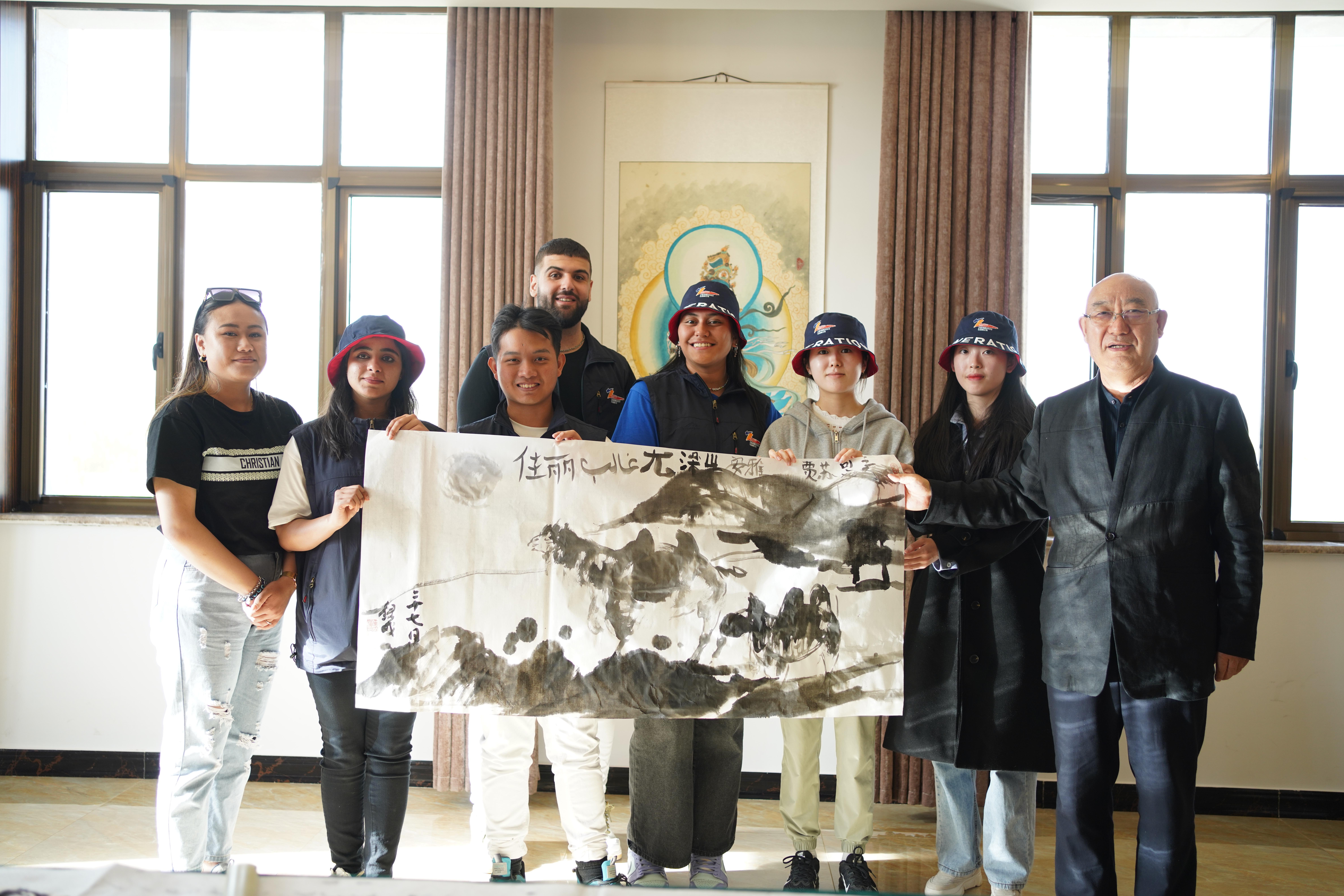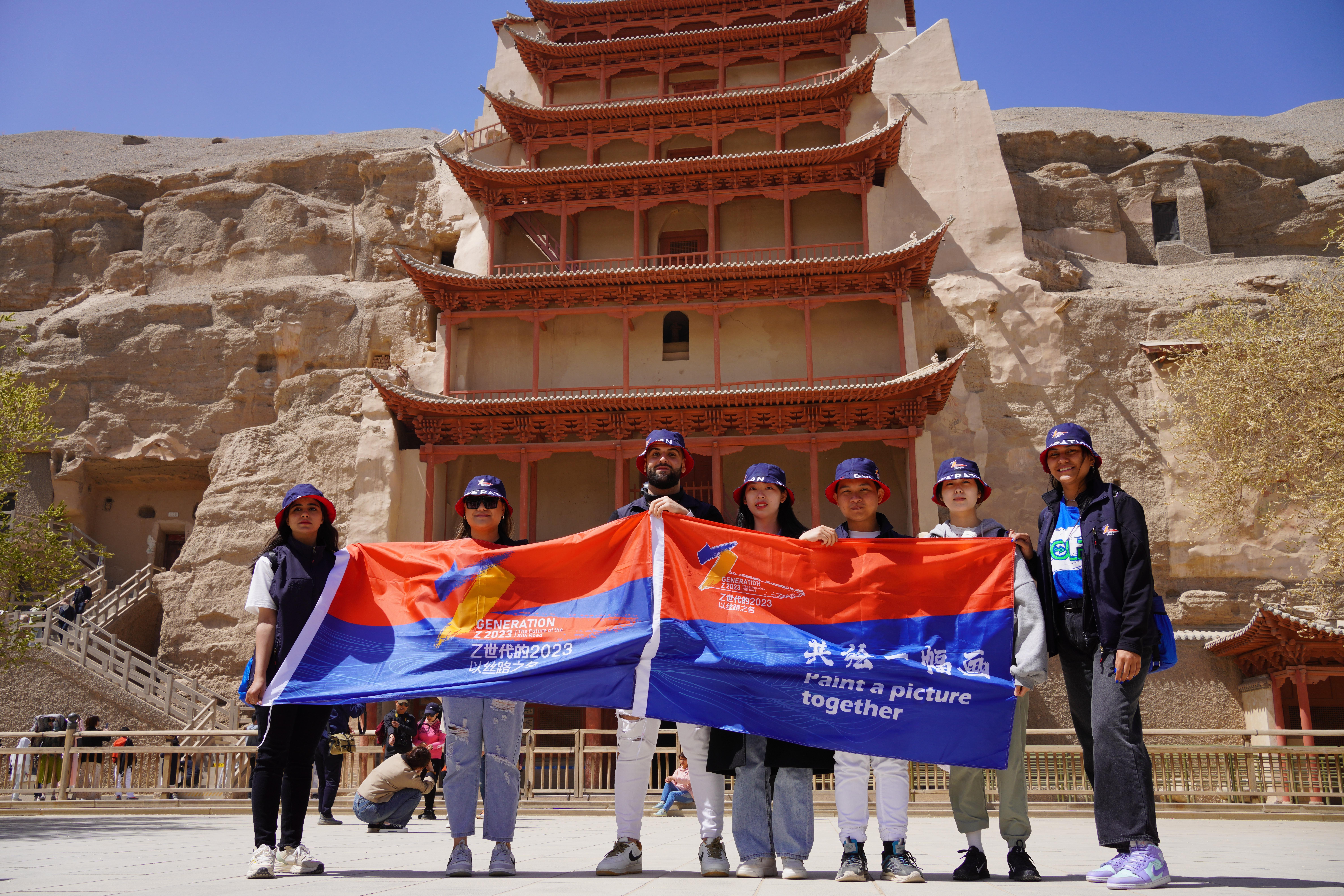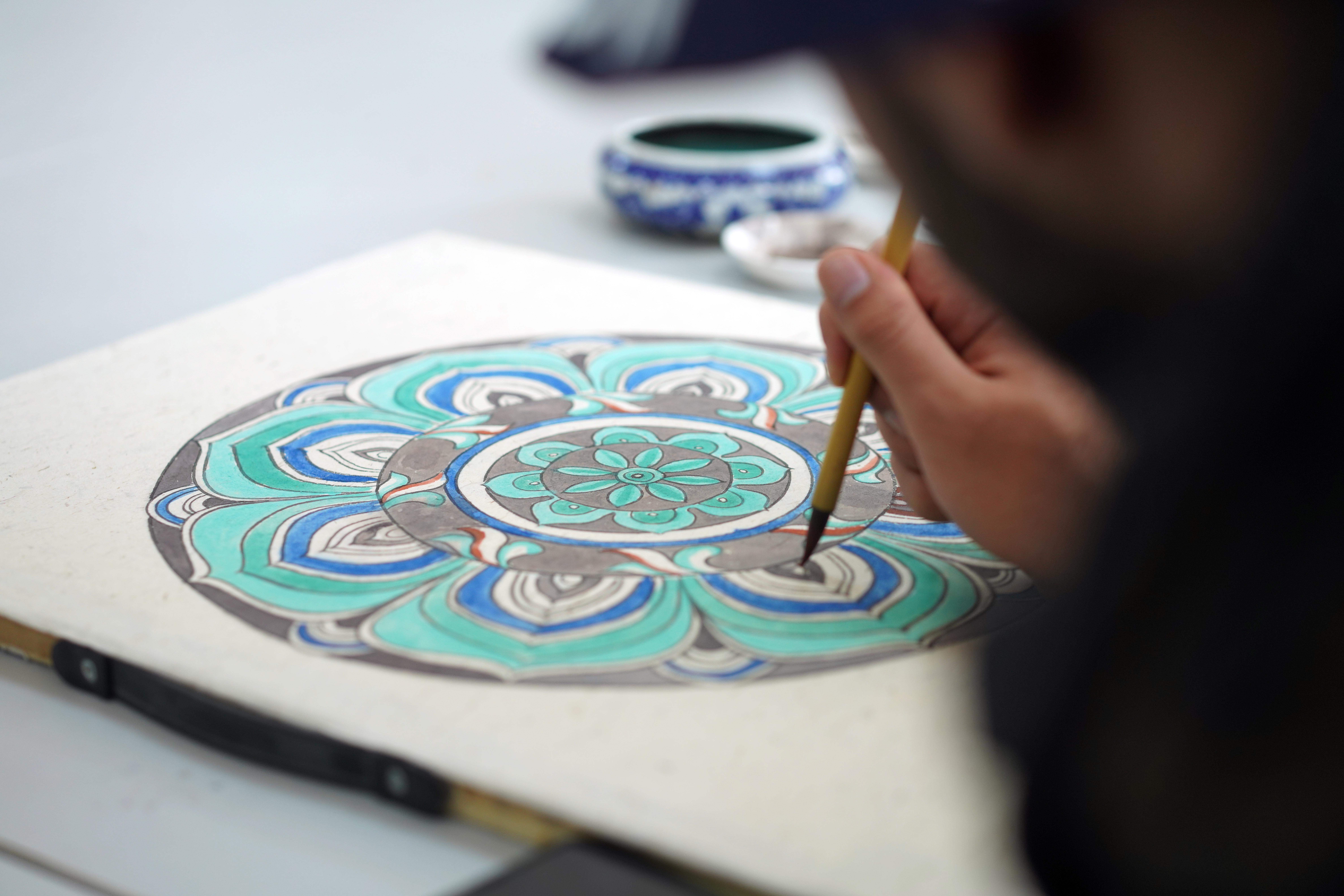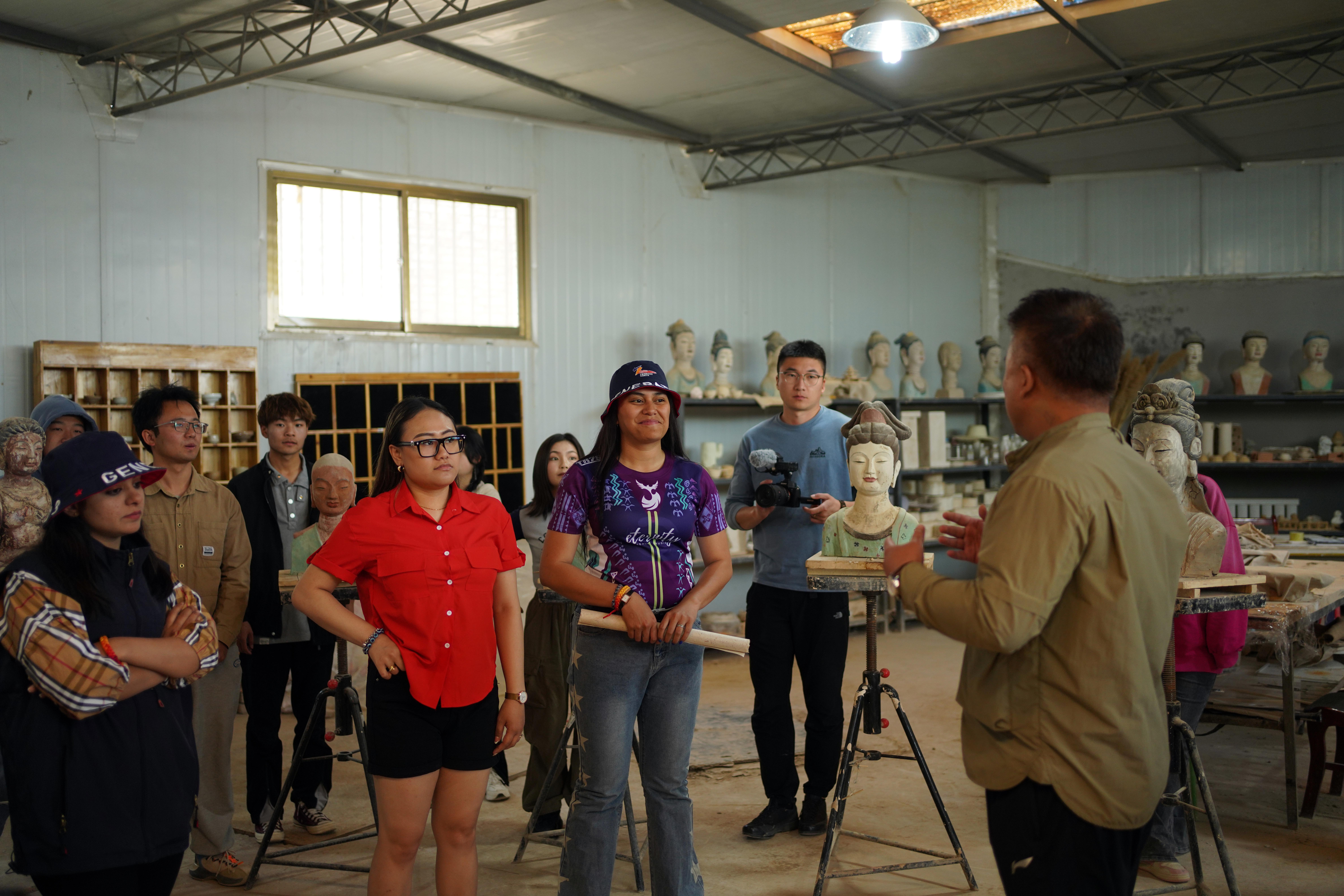International students from Chinese universities get to see the splendor of the Mogao Caves and murals in Gansu province, Deng Zhangyu reports.
 Students taking part in a cultural trip, organized by the China Public Relations Association, complete an ink painting focusing on camels in the desert with the help of artist Zhang Lucheng (first from right). (HU JUN / FOR CHINA DAILY)
Students taking part in a cultural trip, organized by the China Public Relations Association, complete an ink painting focusing on camels in the desert with the help of artist Zhang Lucheng (first from right). (HU JUN / FOR CHINA DAILY)
When Juni Stefanus Santoso from Indonesia rode a camel in a desert in Dunhuang, Gansu province — an important cultural hub on the Silk Road where cultures from the East and the West met and mixed hundreds of years ago — he felt like he was "stepping into another world" that was exotic, and very different from his previous impression of China.
On a four-day trip to Dunhuang in late April, Santoso, together with other foreign students, mostly from nations along the Silk Road, embarked on a cultural journey to explore the desert landscape, visit the local museum, the Mogao Caves and craftsmen who paint murals and produce Buddhist statues, and communicate with students from the Dunhuang College of Northwest Normal University. All of these activities offered the 23-year-old Indonesian an immersive experience, through which he could soak in the culture of ancient China.
Painting from Europe and Asia blends with Chinese art in Dunhuang. Chinese art started here and was spread to the world, only to return to China after being mixed with the art of other nations.
Zhang Lucheng, artist
"It was so amazing. I never knew that there would be camels in China. It's like another side of the country," says Santoso, who began to study for his master's degree in computer science in Tiangong University in Tianjin last year.
Before he came to China, he thought it was a country full of technology-related companies — an impression that was bolstered by the fast and convenient technology-driven services that came to be a part of his daily life when he moved to Tianjin.
"I was impressed by China's science and technologies before coming to China. Here, everything is very convenient and interconnected. You can do everything on your phone," says Santoso, referring to services like electronic payment and online shopping.
The cultural trip, however, showed Santoso a view of China when art and goods were transported along the Silk Road more than a thousand years ago. The young man says he was taught a little bit about the Silk Road in his middle school history class.
His grandmother was a Chinese-Indonesian. He was even given a Chinese name, You Liangshan, when he was born. Every year, his family celebrates the Chinese Lunar New Year and they send red envelopes filled with money to young family members — a Lunar New Year tradition.
 Pakistani Jalil Fazila, a doctoral student from the University of Science and Technology Beijing, colors a pattern copied from murals in the Mogao Caves with the help of a student from the Dunhuang College of Northwest Normal University in Dunhuang, Gansu province. (HU JUN / FOR CHINA DAILY)
Pakistani Jalil Fazila, a doctoral student from the University of Science and Technology Beijing, colors a pattern copied from murals in the Mogao Caves with the help of a student from the Dunhuang College of Northwest Normal University in Dunhuang, Gansu province. (HU JUN / FOR CHINA DAILY)
Santoso says he became interested in Chinese culture as a child. He even learned Chinese calligraphy for half a semester, which helped a little when he was invited to an ink painting with a Chinese artist.
All the students taking part in the cultural trip, organized by the China Public Relations Association, were invited to paint a picture together, although it was their first time drawing with ink on rice paper.
Ink painter Zhang Lucheng taught them how to do it and helped improve the painting. Zhang asked the students to carefully observe camels when riding them because camels would be the subject of the painting.
"The camel is a cultural symbol on the Silk Road. It can also be seen as a medium to spread art and culture along the route. Perceptions of camels by people across the globe are the same," explains Zhang on why he chose camels as a subject for these students, most of whom had never experienced using an ink brush before.
Zhang's style is daxieyi, an abstract ink painting that uses relaxed freehand techniques. In just several strokes, with Zhang's deft brushwork, the camel takes shape and the desert appears.
"Daxieyi demonstrates a kind of Chinese philosophy. You don't draw everything in detail, but leave a space for viewers to imagine," he says.
"The landscapes along the Silk Road are magnificent. Mountains, grasslands and desert, they are all very splendid and grand. Applying daxieyi style enables us to express that in the best possible way."
 International students take a cultural trip to Dunhuang and pose for pictures in front of the Mogao Caves. (HU JUN / FOR CHINA DAILY)
International students take a cultural trip to Dunhuang and pose for pictures in front of the Mogao Caves. (HU JUN / FOR CHINA DAILY)
Zhang drew a camel in the center of the painting, and students added in other elements, such as the sun, the footprints of the camels, mountains, plants and houses. Finally, they were encouraged to write their names on it in their own language to jointly complete the painting.
The artist says the creation process was interesting. It's a mix of people from various cultural backgrounds, just like Dunhuang, where art from the East and the West combines with each other.
He mentions the Mogao Caves, which the students visited. The UNESCO World Heritage Site is home to hundreds of grottoes that house thousands of murals and statues and is one of the finest Buddhist art collections in China. Traces of how the art was introduced to China from the West and localized by Chinese artists can be easily found in the murals.
"Painting from Europe and Asia blends with Chinese art in Dunhuang. Chinese art started here and was spread to the world, only to return to China after being mixed with the art of other nations," adds Zhang.
Santoso says he can tell the difference between the Buddha figures painted on the murals and those in his culture. As a Buddhist himself, he was fascinated by the art in the caves.
 A student from Syria copies a pattern from the murals in the Mogao Caves at the college. (HU JUN / FOR CHINA DAILY)
A student from Syria copies a pattern from the murals in the Mogao Caves at the college. (HU JUN / FOR CHINA DAILY)
Jalil Fazila from Pakistan was also stunned by the murals and their bright colors, as well as their good condition after more than 1,000 years.
"For me, painting is an activity through which we can express our feelings with a pen and vivid colors. It's a convenient way to spread a message and enable people in other places to understand us," says the 26-year-old doctoral student from the University of Science and Technology Beijing. She painted a camel on the rice paper, which she says looked "very weird" compared with Zhang's. Her first time painting inspired her to learn more about Chinese culture in the future.
Fazila's most memorable experience on the trip was her spontaneous dancing with students from the Dunhuang College of Northwest Normal University, where Fazila and her peers were taught a Dunhuang-style dance, choreographed based on figures depicted in the murals at the Mogao Caves.
The costumes that the dancers wore are similar to those worn in one province of Pakistan, says Fazila, and their moves and gestures reminded her of Indian dancing, which is also similar to that of her hometown. "I don't know what made me dance spontaneously with these men and women. Maybe the environment, the passion or the music. At that moment, I just wanted to dance with them. So amazing and exciting," says Fazila.
She danced in her own style while surrounded by other students performing the Dunhuang dance. She also invited these local dancers to join her in performing to a piece of Pakistani music.
 A sculpture teacher from the Dunhuang College of Northwest Normal University showcases the process of producing Buddhist statues to international students in Dunhuang. (HU JUN / FOR CHINA DAILY)
A sculpture teacher from the Dunhuang College of Northwest Normal University showcases the process of producing Buddhist statues to international students in Dunhuang. (HU JUN / FOR CHINA DAILY)
Fazila came to Beijing for her master's degree in 2019. She is from Lahore, the second-largest city in Pakistan, which boasts many historical landmarks.
She is also interested in Chinese culture. The Dunhuang trip for her is about gaining knowledge.
"I explored so many things about the tradition, the history, the religion and the mural art. I hope to stay in China in the future to learn more about the country," she says.
At the Dunhuang college, Fazila and other students were grouped with art students to color patterns copied from Dunhuang murals, which was "a very different artistic experience", she says.
Ink painter Zhang says that the murals are essential learning for Chinese ink painters, who want to enhance their skills.
When Zhang was in his 20s, he stayed in Dunhuang for several years to learn from the murals. At that time, even the harsh environment couldn't smother Zhang's passion to learn. "The art in Dunhuang is a mix of the world's art. For Chinese artists, it influences our skills and is a source of creativity and inspiration for our production," says Zhang.
The cultural trip is part of a program, titled Generation Z 2023: The Future of the Silk Road, to invite students from various cultural backgrounds in China to experience Chinese culture. It has also organized another two trips, including one for music and one for food, which took place late last month.
Contact the writer at dengzhangyu@chinadaily.com.cn


